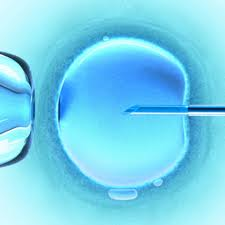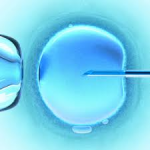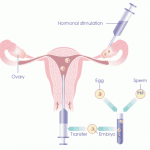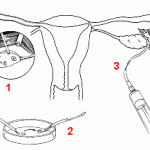What is intrauterine insemination (IUI)?
Intrauterine insemination (IUI) is an infertility treatment that is often called artificial insemination. In this procedure, the woman is injected with specially prepared sperm. Sometimes the woman is also treated with medicines that stimulate ovulation before IUI.
IUI is often used to treat—
- Mild male factor infertility
- Women who have problems with their cervical mucus
- Couples with unexplained infertility
What is assisted reproductive technology (ART)?
Assisted reproductive technology (ART) is a group of different methods used to help infertile couples. ART works by removing eggs from a woman’s body. The eggs are then mixed with sperm to make embryos. The embryos are then put back in the woman’s body.
How often is assisted reproductive technology (ART) successful?
Success rates vary and depend on many factors. Some things that affect the success rate of ART include—
- Age of the partners
- Reason for infertility
- Clinic
- Type of ART
- If the egg is fresh or frozen
- If the embryo is fresh or frozen
CDC collects success rates on ART for some fertility clinics. According to the CDC’s 2010 Preliminary ART Success Rates, the average percentage of ART cycles that led to a live birth were—
- 42% in women younger than 35 years of age
- 32% in women aged 35–37 years
- 22% in women aged 38–40 years
- 12% in women aged 41–42 years
- 5% in women aged 43–44 years
ART can be expensive and time-consuming. But it has allowed many couples to have children that otherwise would not have been conceived. The most common complication of ART is multiple fetuses. But this is a problem that can be prevented or minimized in several different ways.
What are the different types of assisted reproductive technology (ART)?
Common methods of ART include—
- In vitro fertilization (IVF) means fertilization outside of the body. IVF is the most effective ART. It is often used when a woman’s fallopian tubes are blocked or when a man produces too few sperm. Doctors treat the woman with a drug that causes the ovaries to produce multiple eggs. Once mature, the eggs are removed from the woman. They are put in a dish in the lab along with the man’s sperm for fertilization. After 3 to 5 days, healthy embryos are implanted in the woman’s uterus.
- Zygote intrafallopian transfer (ZIFT) or Tubal Embryo Transfer is similar to IVF. Fertilization occurs in the laboratory. Then the very young embryo is transferred to the fallopian tube instead of the uterus.
- Gamete intrafallopian transfer (GIFT) involves transferring eggs and sperm into the woman’s fallopian tube. So fertilization occurs in the woman’s body. Few practices offer GIFT as an option.
- Intracytoplasmic sperm injection (ICSI) is often used for couples in which there are serious problems with the sperm. Sometimes it is also used for older couples or for those with failed IVF attempts. In ICSI, a single sperm is injected into a mature egg. Then the embryo is transferred to the uterus or fallopian tube.
ART procedures sometimes involve the use of donor eggs (eggs from another woman), donor sperm, or previously frozen embryos. Donor eggs are sometimes used for women who can not produce eggs. Also, donor eggs or donor sperm is sometimes used when the woman or man has a genetic disease that can be passed on to the baby. An infertile woman or couple may also use donor embryos. These are embryos that were either created by couples in infertility treatment or were created from donor sperm and donor eggs. The donated embryo is transferred to the uterus. The child will not be genetically related to either parent.
Surrogacy
Women with no eggs or unhealthy eggs might also want to consider surrogacy. A surrogate is a woman who agrees to become pregnant using the man’s sperm and her own egg. The child will be genetically related to the surrogate and the male partner. After birth, the surrogate will give up the baby for adoption by the parents.
Gestational Carrier
Women with ovaries but no uterus may be able to use a gestational carrier. This may also be an option for women who shouldn’t become pregnant because of a serious health problem. In this case, a woman uses her own egg. It is fertilized by the man’s sperm and the embryo is placed inside the carrier’s uterus. The carrier will not be related to the baby and gives him or her to the parents at birth.
Recent research by the Centers for Disease Control showed that ART babies are two to four times more likely to have certain kinds of birth defects. These may include heart and digestive system problems, and cleft (divided into two pieces) lips or palate. Researchers don’t know why this happens. The birth defects may not be due to the technology. Other factors, like the age of the parents, may be involved. More research is needed. The risk is relatively low, but parents should consider this when making the decision to use ART.



